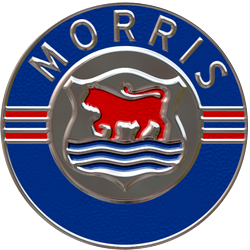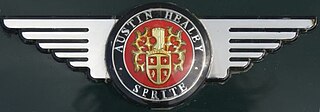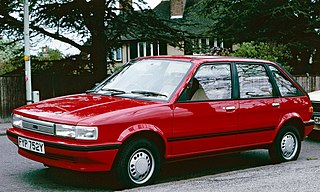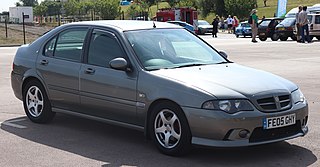
MG is a British automotive marque founded by Cecil Kimber in the 1920s, and M.G. Car Company Limited was the British sports car manufacturer that made the marque famous. Best known for its open two-seater sports cars, MG also produced saloons and coupés, with engines up to three litres in size. The marque is now owned by state-owned Chinese company SAIC Motor Corporation Limited.

Morris Motors Limited was a British privately owned motor vehicle manufacturing company formed in 1919 to take over the assets of William Morris's WRM Motors Limited and continue production of the same vehicles. By 1926 its production represented 42 per cent of British car manufacture—a remarkable expansion rate attributed to William Morris's practice of buying in major as well as minor components and assembling them in his own factory. Self-financing through his enormous profits Morris did borrow some money from the public in 1926 and later shared some of Morris Motors' ownership with the public in 1936 when the new capital was used by Morris Motors to buy many of his other privately held businesses.

The Morris Marina is a front-engined, rear-wheel-drive small family car that was manufactured by the Austin-Morris division of British Leyland from 1971 until 1980. It served to replace the Morris Minor in the Morris product line, which had first been built in 1948. The Marina was also sold in some markets as the Austin Marina, the Leyland Marina and the Morris 1700.

The Austin-Healey Sprite is a small open sports car produced in the United Kingdom from 1958 until 1971. The Sprite was announced to the press in Monte Carlo by the British Motor Corporation on 20 May 1958, two days after that year's Monaco Grand Prix. It was intended to be a low-cost model that "a chap could keep in his bike shed", yet be the successor to the sporting versions of the pre-war Austin Seven. The Sprite was designed by the Donald Healey Motor Company, with production being undertaken at the MG factory at Abingdon. It first went on sale at a price of £669, using a tuned version of the Austin A-Series engine and as many other components from existing cars as possible to keep costs down.

The Austin Maestro is a five-door hatchback small family car that was produced from 1982 to 1987 by British Leyland, and from 1988 until 1994 by Rover Group, as a replacement for the Morris Marina and Austin Allegro. The car was produced at Morris' former Oxford plant, also known as Cowley, with 605,000 units sold. Today, the redeveloped factory builds the BMW Mini. An MG-branded performance version was sold as the MG Maestro from 1983 until 1991.

The Austin Montego is a British family car that was produced by British Leyland from 1984 until 1988, and then by Rover Group from 1988 until 1995. The Montego was the replacement for both the rear-wheel drive Morris Ital and the front-wheel drive Austin Ambassador ranges to give British Leyland an all-new competitor for the Ford Sierra and Vauxhall Cavalier.

The MG ZS is a sports family car that was built by MG Rover from 2001 until 2005. The ZS is essentially a tuned version of the Rover 45. The 45 in turn is a facelifted version of the Rover 400 which was launched in hatchback form in 1995 and saloon form in 1996.

The MG F and MG TF are mid-engined, rear wheel drive roadster cars that were sold under the MG marque by three manufacturers between 1995 and 2011.

Gilbern, Gilbern Sports Cars (Components) Ltd , was a Welsh car manufacturer from 1959 to 1973, based in Llantwit Fardre, Pontypridd, Glamorgan, Wales.

Rochdale cars were a series of mainly glass fibre bodied British sports car made by Rochdale Motor Panels and Engineering in Rochdale, Greater Manchester, England between 1948 and 1973. The company is best remembered for the Olympic coupé made between 1959 and 1973.

The Range Rover Classic is a 4x4, mid-size Sport utility vehicle series produced from 1969 to 1996 – initially by the Rover division of British Leyland, and latterly by the Rover Group.
The TMC Costin is a Clubman-style sports car built from 1983 to 1987 in Castlebridge, County Wexford, Republic of Ireland. Fewer than forty were produced.

The BL O-series engine is a straight-4 automobile engine family that was produced by the Austin-Morris division of British Leyland (BL) as a development of the BMC B-series engine family.
Sylva Autokits is a kit car manufacturer based in Lincolnshire, England. Sylva was founded in 1981 by Jeremy Phillips and has developed and produced a number of small and lightweight sports cars. Sylva cars have won a number of 750 Motor Club Kit Car championships.
Standard was an Indian brand of automobile which was produced by Standard Motor Products of India Limited (SMPIL) in Madras from 1951 to 1988. Indian Standards were variations of vehicles made in the United Kingdom by Standard-Triumph. Standard Motor Products of India Ltd. (STAMPRO) was incorporated in 1948, a company formed by Union Company (Motors) Ltd. and the British Standard Motor Company. Their first product was the Standard Vanguard. The company was dissolved in 2006 and the old plant was torn down.
Fiberfab was an American automotive manufacturer established in 1964. Starting with accessories and body parts, they progressed to making kit cars and fully assembled automobiles. They became one of the longest lasting kit car manufacturers.
British Motor Corporation (Australia) was a motor manufacturing company formed in Australia in 1954 by the merger of the Austin Motor Company (Australia) and Nuffield (Australia). This followed the merger in 1952 of the Austin Motor Company and the Nuffield Group in the United Kingdom to form the British Motor Corporation. Following further corporate changes in the UK in the late 1960s, BMC Australia was absorbed into the newly established British Leyland Motor Corporation of Australia, the name of which became Leyland Motor Corporation of Australia in 1972, and then JRA Limited in March 1983.

Eagle Cars Limited was an English company, based in Lancing, West Sussex, originally operated by Allen Breeze, although it has undergone a number of ownership changes since. Originally making a Jeep lookalike called the RV, between 1981 and 1998 they built several iterations of a gull-winged car called the Eagle SS. The SS was based on an American kit car called the Cimbria, and was brought to the UK by Tim Dutton. In 1988 Eagle Cars moved inland, to nearby Storrington.

Alternative Cars Limited is a New Zealand-based kit car company that manufactures fiber-glass bodied cars based on the 1950s MG TF. The company was founded by Russell Hooper, a medical supply representative, as Kit Kars Limited in 1984. In 1996 Kit Kars Ltd changed its name to Alternative Cars Limited. Initially the company operated from the owner's home, until moving to a small 600 square foot workshop in Auckland.
Sipani Automobiles Ltd. was an Indian car manufacturer established in 1973, located in Bangalore. They mainly manufactured subcompact cars with fibreglass bodies. They also took over Auto Tractors Limited in 1991 and manufactured diesel engines and tractors in the old ATL factory in Pratapgarh, Uttar Pradesh.














